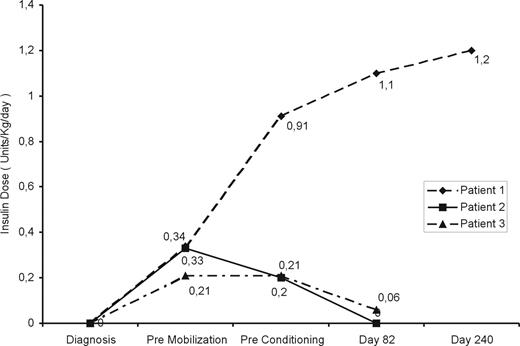Abstract
Insulin-dependent type I diabetes mellitus (IDDM) is caused by autoimmune destruction of pancreatic β-islet cells mediated by inflammatory T cells. The pathogenic process evolves gradually for several years and becomes symptomatic when most Langerhans islands are destroyed. Antibodies against β-cell antigens (like anti-glutamic acid decarboxylase, GAD) are markers of the autoimmune reaction and levels of proinsulin C-peptide correlate with endogenous insulin secretion. Several immunosuppressive regimens have demonstrated clinical and laboratorial benefit in early onset IDDM, presumably sparing islets reserve, but most responses were transient and long term toxicity limited their continuous use. In view of durable remissions observed in various autoimmune diseases treated with high-dose immunosuppression and autologous hematopoietic stem cell transplantation (AHSCT), we started in December/03 a phase I/II trial of AHSCT in early-onset IDDM. Patients from 12–35 years old with <6 weeks from diagnosis have their peripheral blood stem cells mobilized with 2 g/m2 cyclophosphamide and 10 mcg/kg G-CSF, cryopreserved and reinfused (>2 million/kg) after conditioning with 200 mg/kg cyclophosphamide and 4,5 mg/kg rabbit antithymocyte globulin- ATG (Thymoglobuline, SangStat). End points of the study are insulin needs (U/kg/d), glycosilated hemoglobin levels, anti-GAD titers and C-peptide levels. Four patients have been transplanted and the insulin usage of the first three patients is shown in the Figure. The first patient received high dose of steroids to prevent ATG hypersensitivity and showed increasing needs of insulin after mobilization. The other two patients received minimal (#2) or no (#3) steroid dose during conditioning and showed decreasing needs of insulin after mobilization (Figure). Patient #2 presented bilateral pneumonia while pancytopenic, recovered after treatment with antibiotics and Amphotericin-B but did not require insulin therapy. A fourth patient has just been discharged from the BMT Unit. Immunologic studies in the three patients with longer follow-up showed a progressive shift from Th1 to Th2 cytokine profile after transplantation which could provide a mechanism for the modulation of the autoimmune process by high dose immunosuppression and autologous HSC. In conclusion, the preliminary results are encouraging but must be validated with a larger number of patients (12 planned in this phase) and a longer followup (5 years).
Financial support: Ministry of Health, FAEPA-HCRP, FAPESP, FUNDHERP, FINEP, CNPq.
Author notes
Corresponding author


